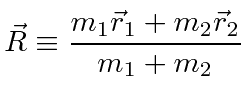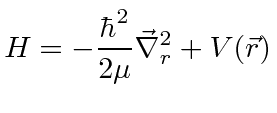Next: Identical Particles Up: Extending QM to Two Previous: Quantum Mechanics in Three Contents
The generalization of the Hamiltonian to three dimensions is simple.

 |
 |
We will use the chain rule to transform our Hamiltonian.
As a simple example, if we were working in one dimension we might
use the chain rule like this.

In three dimensions we would have.


Putting this into the Hamiltonian we get
![\begin{displaymath}\bgroup\color{black}H={-\hbar^2\over 2m_1}\left[\vec{\nabla}_...
...1\over m_1+m_2}\vec{\nabla}_r\cdot\vec{\nabla}_R\right] \egroup\end{displaymath}](img1600.png)
![\begin{displaymath}\bgroup\color{black}\qquad +{-\hbar^2\over 2m_2}\left[\vec{\n...
...m_2}\vec{\nabla}_r\cdot\vec{\nabla}_R\right]+V(\vec{r}) \egroup\end{displaymath}](img1601.png)
![\begin{displaymath}\bgroup\color{black}H=-\hbar^2\left[ \left({1\over 2m_1}+{1\o...
...2\over 2(m_1+m_2)^2}\vec{\nabla}_R^2\right]+V(\vec{r}) .\egroup\end{displaymath}](img1602.png)
Defining the reduced mass
![]()
 |
 |
 |
The Hamiltonian actually separates into two problems:
the motion of the center of mass as a free particle

 |
This is exactly the same separation that we would make in classical physics.
Jim Branson 2013-04-22